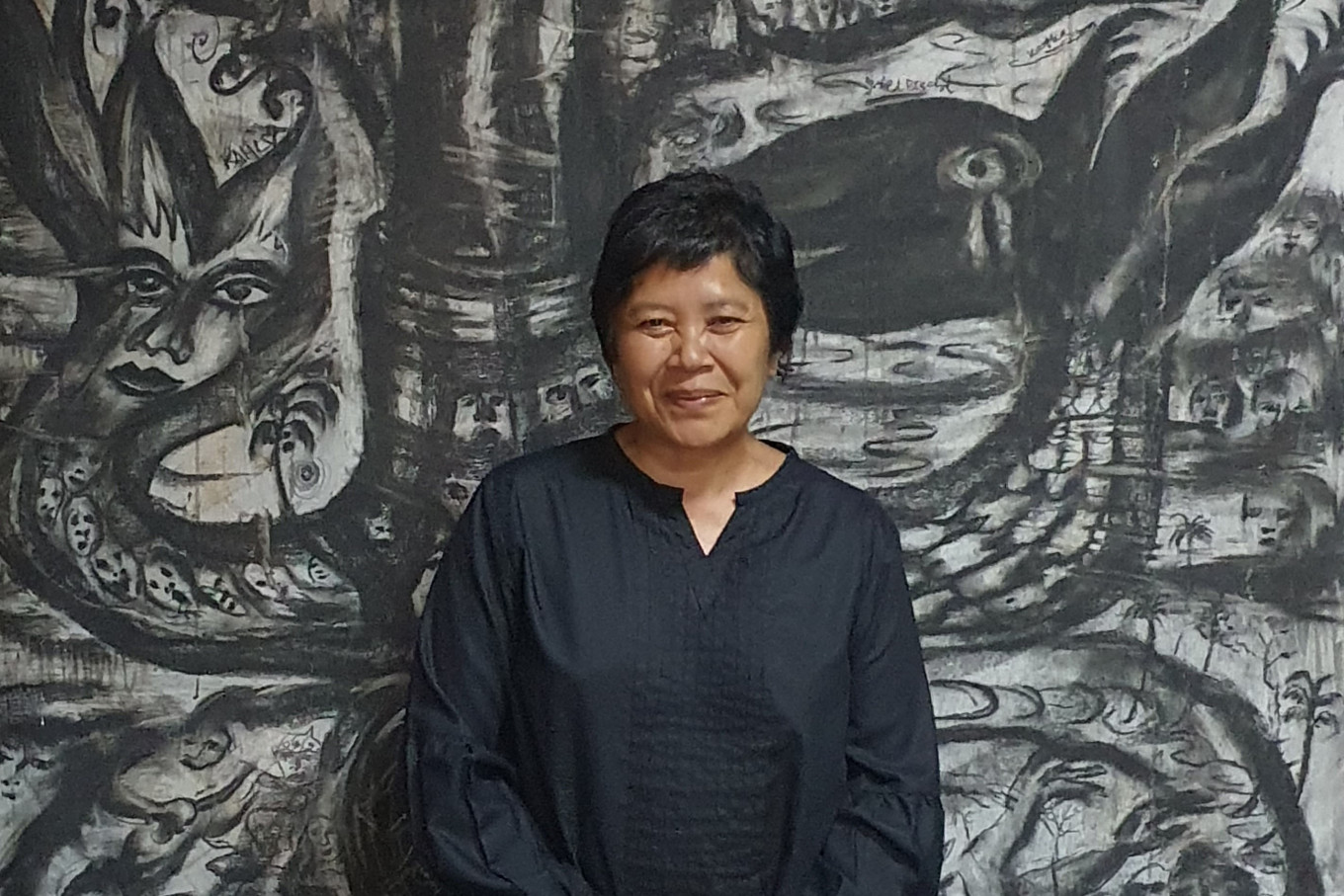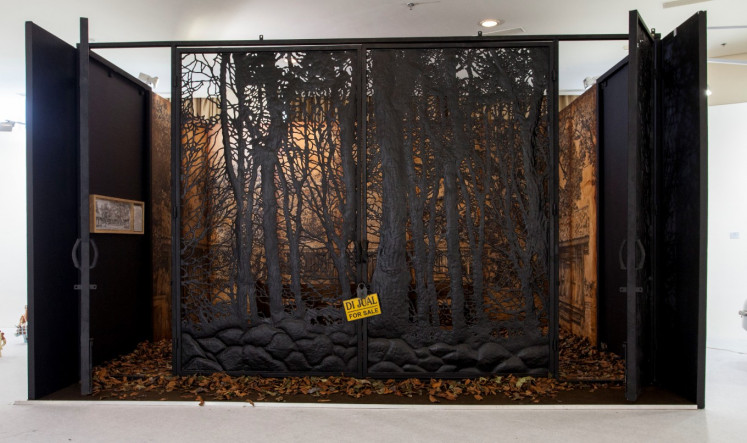Popular Reads
Top Results
Can't find what you're looking for?
View all search resultsPopular Reads
Top Results
Can't find what you're looking for?
View all search resultsA path forward for Indonesian art during troubled times: Dialogue with Andonowati
The infrastructure in Indonesia is far from ideal for the development of art, says Indonesian art visionary Aan Andonowati, but that has not deterred her from doing what she can to create a bright future of art in the country.
Change text size
Gift Premium Articles
to Anyone
I
ndonesian art visionary Aan Andonowati initially developed her creative prowess within the field of applied mathematics. Born in Magelang, Central Java, in 1963, her parents forbid her to engage in art and music as a child. From the age of 6, her mother sent her to private mathematics classes, believing this was an avenue to her daughter’s future prosperity.
In 1995, Aan received a PhD in mathematical physics from McGill University in Montreal, Canada, and afterward she worked as a researcher and a faculty lecturer at McGill for two years. She then affiliated with the Applied Analysis and Mathematical Physics Group at University of Twente, Netherlands.
While living in Montreal, Aan's passion for fine arts led her to embark upon art market practices in Canada. Returning to Indonesia in 1999 to work at the Bandung Institute of Technology (ITB), she began collecting artworks mostly from Indonesian artists. Among other appointments and achievements, her fascination of mathematical modeling and simulation focused upon coastal oceanography and environmental water helped inspired a new independent research institute, LabMath-Indonesia, which she cofounded with her husband in 2006.
Aan’s first venture into the Indonesian art world began in 2007 with ArtSociates, an art and artist management enterprise to promote local artists within the national and international spheres. ArtSociates later hosted a private art and science estate, Lawangwangi, from late 2009. The following year, Aan initiated the Bandung Contemporary Art Awards, biannual prizes to encourage talented emerging artists to explore their ideas using diverse media. In 2012, Lawangwangi evolved with an emphasis on sustainability and was rebranded as Lawangwangi Creative Space with the vision of becoming a distinct art park and a center for the advancement of art and culture in Bandung. As the chief director of PT Lawangwangi, her company’s projects focus upon the hospitality industry integrated with art and nature. (https://www.instagram.com/artsociates.id/) (https://www.artsociates.com/) (https://www.lawangwangi.com/)
Newly opened in early September, Sakarsa Art Space owned by Sakti Wahyu Trenggono in Bekasi, West Java, is currently managed by Aan. The opening was delayed due to the pandemic, but she is optimistic, believing the venue will help to revitalize the art scene by creating a new cluster of collectors. Aan recently expressed her thoughts and ideas about the future of the Indonesian art world and some of her projects.
What are the factors (pre-COVID) inhibiting the development of Indonesian contemporary art?
The infrastructure for a healthy development of Indonesian art is far from ideal. There are no international standard museums as key reference points to inform society, public art is not encouraged and structural government support for artists does not exist. The Indonesian art market is, however, among the largest in Southeast Asia, because many private patrons have supported the art industry. Unfortunately, until the boom in 2008, the art market was partly driven by auction prices, and we often observed that there was no correlation between the price and the artists' portfolios. Relations between collectors, galleries and artists were not harmonious, which made it difficult to create a healthy art market in Indonesia.
What are some practical solutions to help correct these problems?
For government policymakers, it is time to create a National Art Council with members from all stakeholders of the art community, including curators, artists, museum directors, gallerists, collectors and art biennale and art fair directors. The council could create programs to promote Indonesian art with requirements for public and private buildings to display art in their public spaces. An inventory of National Assets in Art for existing and future art acquisitions could be developed. Establish international standard museums as public art references and make a financial scheme for art donations and art event support. For art galleries, artists and collectors, it is time to build respectful and sustainable long-term relationships where galleries have as targets the promotion of their representative artist. Artists produce their best works for the representing galleries, while collectors make art acquisitions through galleries.
How can we draw a new generation of collectors to Indonesian art?
Appreciating and collecting art needs to be perpetuated. Each exhibition should come with programs: regular guided tours, school children visits to galleries, artist talks and classes for art appreciation for possible new collectors. ArtSociates/Lawangwangi does most of these programs. At the moment, we are only able to have virtual tours and private guided tours. We also provide interviews with artists and curators, mostly presented on our Instagram.
'Speculative Realism #41Games' (2020) by Jim Allen Abel, 150X100cm inkjet print on professional photo paper mounted on aluminium dB (Courtesy of ArtSociates/Lawangwangi/File)What does innovation mean to you?
Innovation is how the human race progresses to become more empathic toward others along with the better distribution of wealth. Innovation is also a way to grow and achieve sustainability.
Why is it important that innovation becomes a new mantra for the Indonesian art world?
The blessing of contemporary art is that art should speak about context and why it is relevant. This context is a golden gate for Indonesian artists to enter the global scene, because context exists within our rich and dynamic Indonesian sociopolitical culture. Innovation is the rediscovery of the right context presented in the right media, and this stimulates the understanding of what is otherwise hidden.
What positive ideas/developments have occurred during the pandemic that have captured your imagination?
Our art business is structured around the Bandung Contemporary Art Awards, the mechanism for selecting artists that we later manage and promote. While this system is valid, only a minimal number of artists can be part of our promotion into the mainstream market. To expand into a broader market and so enlarge the involvement of artists, I created a new brand, COLABOREA art & design. This serves as pre-order custom art specializing in the needs of the clients, affordable art and art-based designed objects. COLABOREA working & living is also a new brand to further promote the Indonesian creative industry. In this project, we open coworking and coliving spaces with connections to working studios (ceramic, metal, glass). The artists and designers can trial prototype art/design productions while connecting with others via technology startups, for example. Finally, we also reshaped and rebranded our restaurants where the food is curated based upon a six-month theme. This will later evolve with a new concept of curated ghost/cloud kitchens - a gallery culinary show - under the new brand COLABOREA food & culture.
“It is now too late for me to build a career as an artist,” Aan admits. “I do believe, however, I can contribute to a brighter future by building the Indonesian art and cultural infrastructure to encourage creative minds to flourish.” (wng)













